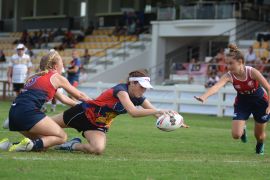Youth development leaders see positive effects from 5th edition rule changes
11 Aug 2021 @ 0:00 UTC
The latest changes to the playing rules for Touch will speed up the game giving playmakers a better chance to break down well-oiled defences.
The latest changes to the playing rules for Touch have received the thumbs up from youth players around the globe. Indeed, the Federation of International Touch (FIT) had planned to formally adopt these rule changes at the Youth World 2021, scheduled for England.
Despite the tournament’s postponement, several nations have trialled the rules. The plan is that FIT will review the latest editions to the regulations following the next major international event.
In a nutshell, the 5th edition rule changes will provide youth players with more space in attack and the incentive to be more positive close to the line in defence, according to Jordan Zhu and David Parker, from Youth Development at FIT. They discussed the impact of the rule changes on youth players when they joined Adam Collins for an episode of ‘Set of Six’.
More room to move
The requirement for defending teams to retire 7 meters from the play the ball, instead of 5 meters, has had a really positive effect on the way Touch is played in China, according to Jordan Zhu, “In China it has made a massive impact. Most of the Touch players in China are from a rugby background so during the game they come back only 2 or 3 metres. Since FIT made the changes and teams are getting back 7 metres it has really increased the pace of the game. It’s made Touch football a better game to watch in China.”
Jordan was particularly excited about the effect this has had on the way the sport is played at the youth level, “When they got the ball they used to run around and not run forward. Now when I watch youth games, I can see the first option taken is to move forward. The rule allows the kids to have more space to run. It’s definitely changed the style of play at the youth level in China.”
David Parker has witnessed a similar outcome for youth Touch in Australia, “For those children with a bit of speed and footwork it has opened up the game for them much more.”
No more marching in defence
The requirement for defending players to move forward at a reasonable pace when they are within 7 metres of their line, and the attacking team has the ball outside of this 7-metre zone, will encourage players to be more positive in defence according to David Parker, “We are running a lot of drills with our youth in getting them to be really positive in going and making touches, showing that intent to get out as the lead defender, trying to get those touches made outside the 7 metres.”
Requiring defending teams to move forward when in close proximity to their line will make Touch a better game to watch, according to Jordan Zhu, “It will not allow defenders to stand behind other defenders. It creates a very positive impact on the game because it brings more fitness requirements for the defenders.”
It could also encourage young players to be more instinctive with their attacking plays near to the line. Having to cope with a defence that moves up and takes space could lead to less structured, more creative play at youth level.
In the spirit of the game
Teaching young players to play Touch in a fair and sporting way is a priority. The 5th edition rule changes have seen the introduction of the ‘Breakaway interchange’ rule which seeks to remove an aspect of the sport that permitted what could be considered unsporting conduct. This rule change does not allow an interchange to be made, if an intercept or line break has occurred, until the next touch or the ball becomes dead. Jordan Zhu noted that this rule change was trialled at the 2018 Youth World Cup in Malaysia.
David Parker is happy with this rule change, “The old rule meant that you could enter the sub box at one end and the other defender could come out at the other end. I like the rule change. It’s not in the spirit of the game the way the old rule was. It’s a good change.”

